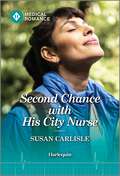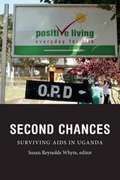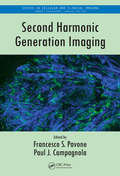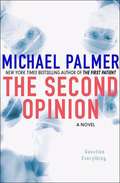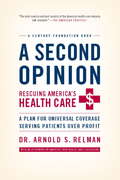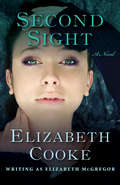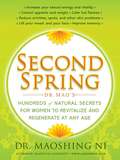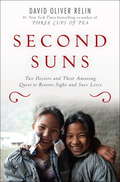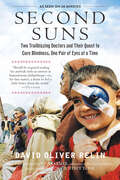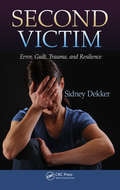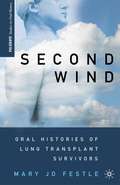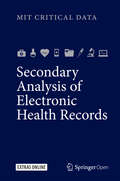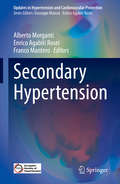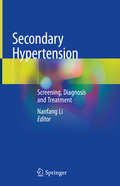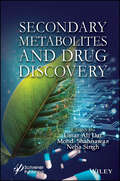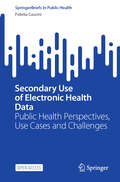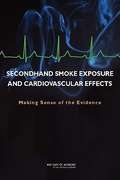- Table View
- List View
Second Chance with His Army Doc: Second Chance With His Army Doc (reunited On The Front Line) / Reawakened By Her Army Major (reunited On The Front Line) (Reunited on the Front Line #1)
by Charlotte HawkesFrom first love…To forever?Fourteen years ago, teenage Kane Wheeler disappeared from Mattie Brigham’s life without a word of explanation. While nothing has filled the void left by Kane, Mattie has forged a successful life as an army doc. When they’re unexpectedly reunited in the line of duty, their attraction is still as fierce as ever. And Kane’s determined to convince Mattie they can still have a happy-ever-after above all!From Harlequin Medical: Life and love in the world of modern medicine.Reunited on the Front LineBook 1: Second Chance with His Army DocBook 2: Reawakened by Her Army Major
Second Chance with His City Nurse
by Susan CarlisleWhen a nurse comes face-to-face with the man who left her at the altar, she tries to forget the ache of the past. But after an unexpected night under the stars sparks honest confessions, will this city nurse dare risk her heart again? Find out in the latest Harlequin Medical Romance novel by Susan Carlisle! ANOTHER SHOT AT FOREVER? When Chicago ER nurse Lily finds herself on an emergency medical assistance program at a clinic in Yosemite National Park, she&’s shocked to find that her course leader is the man who once left her at the altar! She&’d vowed to forget Cade, but when a trek in the forest turns into an unexpected camping trip, a night under the stars sparks a reconnection and an openness far deeper than before. And with that honesty Lily must decide—is she ready to take a leap of faith?From Harlequin Medical: Life and love in the world of modern medicine.
Second Chance with Lord Branscombe
by Joanna NeilThe course of true love never did run smooth... ...and Dr. Sophie Trent knows that better than most! Her romance with Nate Branscombe ended in disaster years before-and now the handsome heir to the local estate is back. Sophie has enough to think about without this charismatic aristocrat's distraction, but as they work closely together he stirs up feelings she thought she'd left firmly behind her. Can the one that got away finally help Sophie face the past...and convince her that true love is here to stay?
Second Chance with the Surgeon: A Christmas Kiss With Her Ex-army Doc / Second Chance With The Surgeon (Mills And Boon Medical Ser.)
by Robin GiannaCan healing his ex-wife……also mend their marriage?When occupational therapist Jillian Keyser breaks her wrist, the last thing she wants is treatment from her ex-husband, Conor McCarthy. But as he is a leading orthopedic surgeon, she knows she needs his help! As she is forced to live again with the man who broke her heart, they discover a new understanding. With their connection as strong as ever, will the Christmas lights over New York shine on their relationship for a second time?“What an emotionally-charged and well-developed read Ms. Gianna has delivered in this book…it was from the moment the hero and heroine come face-to-face for the first time that made this story a real page turner….”—Harlequin Junkie on The Family They’ve Longed For“Definitely an unforgettable romance you won't be able to stop reading once you start so make sure you have the time to give it and author Robin Gianna (who delivers a medical romance with accurate details) your undivided attention because if you don't you will miss a truly heart wrenching and heart melting romance.”—Goodreads on Tempted by the Brooding Surgeon
Second Chances: Surviving AIDS in Uganda
by Susan Reynolds WhyteDuring the first decade of this millennium, many thousands of people in Uganda who otherwise would have died from AIDS got second chances at life. A massive global health intervention, the scaling up of antiretroviral therapy (ART), saved them and created a generation of people who learned to live with treatment. As clients they joined programs that offered free antiretroviral medicine and encouraged "positive living." Because ART is not a cure but a lifelong treatment regime, its consequences are far-reaching for society, families, and individuals. Drawing on personal accounts and a broad knowledge of Ugandan culture and history, the essays in this collection explore ART from the perspective of those who received second chances. Their concerns about treatment, partners, children, work, food, and bodies reveal the essential sociality of Ugandan life. The collection is based on research undertaken by a team of social scientists including both Western and African scholars.Contributors. Phoebe Kajubi, David Kyaddondo, Lotte Meinert, Hanne O. Mogensen, Godfrey Etyang Siu, Jenipher Twebaze, Michael A. Whyte, Susan Reynolds Whyte
Second Harmonic Generation Imaging
by Francesco S. Pavone Paul J. CampagnolaSecond-harmonic generation (SHG) microscopy has shown great promise for imaging live cells and tissues, with applications in basic science, medical research, and tissue engineering. Second Harmonic Generation Imaging offers a complete guide to this optical modality, from basic principles, instrumentation, methods, and image analysis to biomedical a
Second Lover: A Captivating Medical Romance (Medical Romances #13)
by Gill SandersonAnother heartwarming medical romance from best-selling author Gill Sanderson! Perfect for fans of Mia Faye, Laura Scott, Helen Scott Taylor, Grey's Anatomy and ER.Readers ADORE Gill's gripping medical romances!'Remarkable writer!!' 5* author review 'A truly wonderful writer' 5* author review 'I find all of Gill Sanderson's books very readable and enjoy the escapism they give me' 5* author review 'A truly gifted writer with an enormous amount of talent and sensitivity' 5* author review Happiness is within their reach, they know it.But will an unexpected danger tear them apart before she can love again?For Dr Lyn Webster, her move to London is exactly what she needs.After the traumatic death of her fiancé, Gavin, she's ready to concentrate on her work - until her handsome boss Dr Ross McKinnon shows an interest in her. She's devastatingly attracted to him, but he's too similar to Gavin to let herself get close to him; Ross is an adventurer - he wants to work in foreign countries, climb mountains, and sail through rough seas. All Lyn wants is a regular job, a house in the suburbs, and a husband who comes home every night.Don't miss Gill Sanderson's enthralling medical romances, including the A Lakeland Practice and the Good, Bad and Ugly series.
Second Opinion
by Michael PalmerDr. Thea Sperelakis, diagnosed as a teen with Asperger's syndrome, has always been an outsider. She has a brilliant medical mind, and a remarkable recall of details, but her difficulty in dealing with hidden agendas and interpersonal conflicts have led her to leave the complex, money-driven dynamics of the hospital, and to embrace working with the poor, embattled patients of Doctors Without Borders. Her father, Petros, is one of the most celebrated internal medicine specialists in the world, and the founder of the cutting-edge Sperelakis Center for Diagnostic Medicine at Boston's sprawling, powerful Beaumont Clinic. Thea's rewarding life in Africa is turned upside-down when Petros is severely injured by a hit-and-run driver. He is in the Beaumont ICU, in a deep coma. No one thinks he will survive. Thea must return home. Two of Petros' other children, both physicians, battle Thea and her eccentric brother, Dimitri, by demanding that treatment for their father be withheld. As Thea uncovers the facts surrounding the disaster, it seems more and more to be no accident. Petros, himself, is the only witness. Who would want him dead? The answers are trapped in his brain . . . until he looks at Thea and begins slowly to blink a terrifying message. In The Second Opinion, Michael Palmer has created a cat-and-mouse game where one woman must confront a conspiracy of doctors to uncover an evil practice that touches every single person who ever has a medical test. With sympathetic characters and twists and betrayals that come from the most unlikely places, The Second Opinion will make you question...everything.
Second Opinion: A Plan for Universal Coverage Serving Patients Over Profit
by Arnold RelmanDr. Arnold Relman, Professor Emeritus at Harvard Medical School and former editor-in-chief of "The New England Journal of Medicine" brings together sixty years of experience in medicine in a book that holds the keys to a new structure for healthcare based on voluntary private contracts between individuals and not-for-profit, multi-specialty groups of physicians. Timely, provocative, and newly updated, "A Second Opinion" is a clarion call to action. If we heed Dr. RelmanOCOs plan, Americans could at last achieve a lasting, sensible solution to national healthcare.
Second Opinion: The Columbia Presbyterian Guide to Surgery
by Eric A. RoseSecond Opinion is the definitive resource for any of the 15 million people each year who are told they need surgery. This is the one book to turn to when you are sorting out whether or not to have surgery. Dr. Eric Rose and his collegues provide patients a reassuring arsenal of approaches and alternatives so they can participate fully in this important process to assure the best possible outcome. You'll want to bring Second Opinion with you for note-taking, list making, references, and support. It will help you be your own best advocate.Other features include:*45 of the most common operations described in detail*Full illustrations*Reasons to have the operation*What can happen if you don't*Possible complications*What to expect after surgery*Extensive, unbiased resources for getting a second opinion*Patient's worksheets, notes, and rights
Second Sight
by Elizabeth CookeAre the voices Lin Gallagher hears real? Or are they the result of a life-threatening condition? And why, when her life hangs in the balance, does Lin refuse treatment that could save her? Second Sight was adapted into the stage play We Are Gods under the name Elizabeth Cooke. This edition is the first publication of this title outside the United Kingdom.
Second Spring
by Dr Maoshing NiTHE CHINESE REFER TO A WOMAN'S MIDLIFE transition as her Second Spring. Thanks to the simple, natural techniques of traditional Chinese medicine, the second half of a woman's life is a flowering of feminine potential rather than a physical and mental decline. Now, Dr. Mao's revolutionary Second SpringTM program gives you time-tested, completely natural treatments to enhance energy, sexuality, and health -- and initiate your own new season of vitality starting at age thirty-five, through premenopause, menopause, and beyond. Dr. Mao -- Yahoo!'s favorite natural health expert and author of the bestselling Secrets of Longevity -- offers proven natural solutions such as a surgery-free face-lift, Chinese herbs that fight memory loss, traditional remedies that improve libido and sex, and foods that keep your specific body type in peak form (they're not the same for everyone!). His safe, natural practices, outlined in more than 200 tips, can eliminate the need for expensive medicines and artificial hormones. This amazing compendium of traditional wisdom is also enjoyable to read. With chapters on topics like weight, energy, brain power, beauty, and sexual health, Second Spring allows you to target your concerns right away. At the end you'll find handy, at-a-glance lists addressing women's most common ailments. Second Spring, inspired by Dr. Mao's own mother's remarkable transformation in the second half of her life, offers an integrated lifestyle program that will help you live long, live strong, and live happy in ways that you never thought possible.
Second Suns
by David Oliver Relin<P>From the co-author of Three Cups of Tea comes the inspiring story of two very different doctors--one from the United States, the other from Nepal--united in a common mission: to rid the world of preventable blindness. <P> In this transporting book, David Oliver Relin shines a light on the work of Geoffrey Tabin and Sanduk Ruit, gifted ophthalmologists who have dedicated their lives to restoring sight to some of the world's most isolated, impoverished people through the Himalayan Cataract Project, an organization they founded in 1995. Tabin was the high-achieving bad boy of Harvard Medical School, an accomplished mountain climber and adrenaline junkie as brilliant as he was unconventional. Ruit grew up in a remote Nepalese village, where he became intimately acquainted with the human costs of inadequate access to health care. <P>Together they found their life's calling: tending to the afflicted people of the Himalayas, a vast mountainous region with an alarmingly high incidence of cataract blindness. <P>Second Suns takes us from improvised plywood operating tables in villages without electricity or plumbing to state-of-the-art surgical centers at major American universities where these two driven men are restoring sight--and hope--to patients from around the world. With their revolutionary, inexpensive style of surgery, Tabin and Ruit have been able to cure tens of thousands--all for about twenty dollars per operation. <P>David Oliver Relin brings the doctors' work to vivid life through poignant portraits of patients helped by the surgery, from old men who cannot walk treacherous mountain trails unaided to cataract-stricken children who have not seen their mothers' faces for years. With the dexterity of a master storyteller, Relin shows the profound emotional and practical impact that these operations have had on patients' lives. <P>Second Suns is the moving, unforgettable story of how two men with a shared dream are changing the world, one pair of eyes at a time.
Second Suns: Two Trailblazing Doctors And Their Quest To Cure Blindness, One Pair Of Eyes At A Time
by David Oliver RelinNow in paperback: a #1 New York Times–bestselling author’s gripping chronicle of “two doctors . . . bringing light to those in darkness” (Time) Second Suns is the unforgettable true story of two very different doctors with a common mission: to rid the world of preventable blindness. Dr. Geoffrey Tabin was the high-achieving “bad boy” of his class at Harvard Medical School. Dr. Sanduk Ruit grew up in a remote village in the Himalayas, where cataract blindness—easily curable in modern hospitals—amounts to an epidemic. Together, they pioneered a new surgical method, by which they have restored sight to over 100,000 people—all for about $20 per operation. Master storyteller David Oliver Relin brings the doctors’ work to vivid life through poignant portraits of their patients, from old men who can once again walk treacherous mountain trails, to children who can finally see their mothers’ faces. The Himalayan Cataract Project is changing the world—one pair of eyes at a time.
Second Victim: Error, Guilt, Trauma, and Resilience
by Sidney DekkerHow do people cope with having "caused" a terrible accident? How do they cope when they survive and have to live with the consequences ever after? We tend to blame and forget professionals who cause incidents and accidents, but they are victims too. They are second victims whose experiences of an incident or adverse event can be as traumatic as tha
Second Wind
by Mary Jo FestleThis book uses both oral and conventional historical methods to describe and analyze the history of lung transplantation in the U. S. While drawing on accounts from doctors and other specialists, it primarily focuses on the experiences of patients and explores themes of uncertainty, timing, identity, coping, and quality of life.
Secondary Analysis of Electronic Health Records
by Mit Critical DataThis book trains the next generation of scientists representing different disciplines to leverage the data generated during routine patient care. It formulates a more complete lexicon of evidence-based recommendations and support shared, ethical decision making by doctors with their patients. Diagnostic and therapeutic technologies continue to evolve rapidly, and both individual practitioners and clinical teams face increasingly complex ethical decisions. Unfortunately, the current state of medical knowledge does not provide the guidance to make the majority of clinical decisions on the basis of evidence. The present research infrastructure is inefficient and frequently produces unreliable results that cannot be replicated. Even randomized controlled trials (RCTs), the traditional gold standards of the research reliability hierarchy, are not without limitations. They can be costly, labor intensive, and slow, and can return results that are seldom generalizable to every patient population. Furthermore, many pertinent but unresolved clinical and medical systems issues do not seem to have attracted the interest of the research enterprise, which has come to focus instead on cellular and molecular investigations and single-agent (e. g. , a drug or device) effects. For clinicians, the end result is a bit of a "data desert" when it comes to making decisions. The new research infrastructure proposed in this book will help the medical profession to make ethically sound and well informed decisions for their patients.
Secondary Hypertension (Updates in Hypertension and Cardiovascular Protection)
by Enrico Agabiti Rosei Alberto Morganti Franco ManteroThis book offers an overview of the latest advances in the epidemiological, pathophysiological, diagnostic and therapeutic aspects of secondary hypertension, provided by a group of the most highly respected European experts in this field. It is common belief that secondary forms of hypertension are rare, although in 95% of patients the cause of high blood pressure is unknown – euphemistically referred to as “essential”. There is increasing evidence from epidemiological studies that the prevalence of secondary hypertension is much higher than previously thought, accounting for 20%-25% of all hypertensive patients. There are additional, very good reasons for identifying those patients with secondary hypertension: firstly, they are exposed to a greater risk of suffering major cardiovascular events than patients with essential hypertension who have the same blood pressure level, and for this reason require particular care. Secondly, these patients can be relieved of a lifetime of pharmacological therapy or, at least, have a chance to be treated with more specific and effective medications. A high degree of clinical skill is required to recognize the often vague and subtle symptoms and signs that characterize patients with secondary hypertension, and clinicians need to fully comprehend the mechanisms responsible for the development and maintenance of high blood pressure. Shedding new light on a complex area of cardiovascular medicine, the book enables readers to better treat affected patients.
Secondary Hypertension: Screening, Diagnosis and Treatment
by Nanfang LiThis book provides a comprehensive overview of secondary hypertension for clinicians, including cardiologists as well as primary training physicians and general practitioners. A large number of patients suffer from high blood pressure, and it was previously thought that secondary hypertension accounted for 10% of all cases. However, according to new studies, the proportion of secondary hypertension is much higher than this. While hypertensive patients are usually treated in the cardiovascular department, secondary hypertension involves diseases in various fields, such as renal, endocrinological, immunological and urological diseases. This book allows readers to gain a thorough understanding of the screening, diagnosis and treatment of secondary hypertension. It first discusses screening strategies for secondary hypertension, including clinical manifestations, general tests and special tests. It then addresses specific aspects of hypertension related to other diseases, like renal parenchymal diseases; transplantation; congenital diseases; endocrine, neurogenic and psychosocial disorders; vascular conditions; sleep apnoea syndrome, connective tissue disease and metabolic-associated hypertension. Lastly, it covers secondary hypertension related to rare heredity conditions.
Secondary Metabolites and Drug Discovery
by Mohd. Shahnawaz Neha Singh Umar Ali DarThis book explores the promising potential of plant and microbe-derived compounds in drug discovery, offering insights into safer alternatives to synthetic drugs and highlighting the vital role of natural products in treating diseases with fewer side effects. Plants and microbes are a promising source for natural products with the potential to play a major role in drug discovery. Due to advances in the fields of science, technology, engineering, and medicine, the commercial pharmaceutical industry is growing across the globe. Currently, allopathy uses synthetic pharmaceutical drugs for the treatment of diseases, but this practice also exposes patients to significant side effects. Since ancient times, other systems of medicine have been developed that utilize plant-based extracts and molecules to treat various diseases with fewer side effects. While changes in lifestyle, including diet, have had a significant impact on the increased risks of various diseases, there is substantial scientific evidence, both epidemiological and experimental, that vegetables and fruits are key features of diets associated with lower risks of diseases such as cancers and infections. These efforts to identify and create medications from plants are leading to increased manufacturing for larger clinical trials. The continuing scientific research of medicinal plants will undoubtedly provide a wealth of novel, structurally varied, bioactive chemicals. This edited volume provides an overview of various medical systems, with a special focus on microbial and plant-based drug molecules for treating communicable and non-communicable diseases, making it an invaluable resource for researchers, scientists, and practitioners interested in the potential of plant- and microbe-derived secondary metabolites in the ongoing search for innovative, effective, and safer medicines. Readers will find this book: Provides an overview of different types of sources and drug molecules used in allopathic, homeopathic, ayurvedic, Chinese, and Unani systems of medicine; Highlights past and current methods of alternative, complementary, folklore, and integrative medicines; Discusses the benefits and side effects of the drug molecules used in different systems of medicine at the global level; Explores microbial and plant-based drug molecules for treating various communicable and non-communicable diseases. Audience Researchers, academics, industry, and governmental experts working in the fields of natural science, natural products, synthetic chemistry, pharmacology, and medicinal chemistry.
Secondary Qualitative Data Analysis in the Health and Social Sciences
by Cheryl Tatano BeckDespite a long history in quantitative research, it is only recently that enthusiasm for secondary analysis of qualitative data has gained momentum across health and social science disciplines. Given that researchers have long known the inordinate amount of time and energy invested in conducting qualitative research, the appeal of secondary analysis of qualitative data is clear. Involving the use of an existing dataset to answer research questions that are different from those asked in the original study, this method allows researchers to once again make use of their hard-earned qualitative dataset and to listen to their participants’ voices to the best of their ability in order to improve care and promote understanding. As secondary qualitative data analysis continues to evolve, more methodological guidance is needed. This book outlines three approaches to secondary data analysis and addresses the key issues that researchers need to wrestle with, such as ethical considerations, voice, and representation. Intellectual and interpretive hazards that can jeopardize the outcome of these analyses are highlighted and discussed, as are the criteria for assessing their quality and trustworthiness. Written as a thought-provoking guide for qualitative researchers from across the health and social sciences, this text includes a review of the state of the science in nursing and a number of in-depth illustrative case studies.
Secondary Trauma and Burnout in Military Behavioral Health Providers
by Charles C. BenightThis book provides an in-depth look at the complex clinical, individual, and organizational challenges that our clinicians face in treating our returning soldiers struggling with the aftermath of more than a decade of war. The authors explore the confluence of factors that make this time in history a perfect storm for military mental health providers. The signature wounds of the Iraq and Afghanistan wars weave a tapestry of emotional turmoil with diffuse brain injury difficulties that challenge the very best clinicians under the best conditions. The authors target different pieces of the puzzle including the prevalence of secondary trauma and burnout, the organizational factors that promote negative clinician well-being, the creation and evaluation of an online social media based intervention for burnout, and a critical review of peer coaching.
Secondary Use of Electronic Health Data: Public Health Perspectives, Use Cases and Challenges (SpringerBriefs in Public Health)
by Fidelia CasciniThis open access book provides an in-depth overview of the characteristics, significance, backgrounds and limits of the most relevant electronic health data categories used at a global level for secondary purposes. These include healthcare system improvement, patient safety and quality of care, health policymaking, surveillance of diseases, personalized medicine, research and innovation such as artificial intelligence training for clinical practice. A detailed and thorough representation of published evidence, practical experiences and concrete examples is offered to the reader who has the opportunity to explore the main areas of utilization of electronic health records, biobanking data, genetic and &‘omic&’ data, real-world data and many other health data from different sources. The challenges and advantages of health data reuse are explained from a public health perspective that addresses risks, benefits and impacts for different stakeholders such as health data holders (e.g., healthcare providers, pharmaceutical and medical device companies), health authorities and data permit issuers (e.g., health data access bodies), and health data users (e.g., healthcare professionals, researchers, business partners in the healthcare system such as insurers, commercial providers of digital solutions). Given the increasing expansion of health data used for secondary purposes, Secondary Use of Electronic Health Data: Public Health Perspectives, Use Cases and Challenges serves as a go-to resource to facilitate the implementation of health data reuse ecosystems. In this regard, it also highlights emerging opportunities such as the European Health Data Space which is extensively explained.
Secondhand Smoke Exposure and Cardiovascular Effects: Making Sense of the Evidence
by Institute of Medicine of the National AcademiesData suggest that exposure to secondhand smoke can result in heart disease in nonsmoking adults. Recently, progress has been made in reducing involuntary exposure to secondhand smoke through legislation banning smoking in workplaces, restaurants, and other public places. The effect of legislation to ban smoking and its effects on the cardiovascular health of nonsmoking adults, however, remains a question. Secondhand Smoke Exposure and Cardiovascular Effects reviews available scientific literature to assess the relationship between secondhand smoke exposure and acute coronary events. The authors, experts in secondhand smoke exposure and toxicology, clinical cardiology, epidemiology, and statistics, find that there is about a 25 to 30 percent increase in the risk of coronary heart disease from exposure to secondhand smoke. Their findings agree with the 2006 Surgeon General's Report conclusion that there are increased risks of coronary heart disease morbidity and mortality among men and women exposed to secondhand smoke. However, the authors note that the evidence for determining the magnitude of the relationship between chronic secondhand smoke exposure and coronary heart disease is not very strong. Public health professionals will rely upon Secondhand Smoke Exposure and Cardiovascular Effects for its survey of critical epidemiological studies on the effects of smoking bans and evidence of links between secondhand smoke exposure and cardiovascular events, as well as its findings and recommendations.
Secret Sheikh, Secret Baby
by Carol MarinelliSECRET SHEIKH, SECRET BABY Carol Marinelli Hot-shot surgeon Karim Zaraq is also prince of a desert kingdom! When one night with the sexy Sheikh leaves midwife Felicity Anderson pregnant, Karim knows he must do his royal duty. . . But Felicity will only say I do when he proves his proposal is for love. / HIS BABY BOMBSHELL Jessica Matthews The last thing nurse and single mother Sabrina Hollister needs is the father of her baby to turn up as her new boss! Adrian is knocked out by Sabrinas baby secret ; but hes not going to let her raise their son alone. . . /

